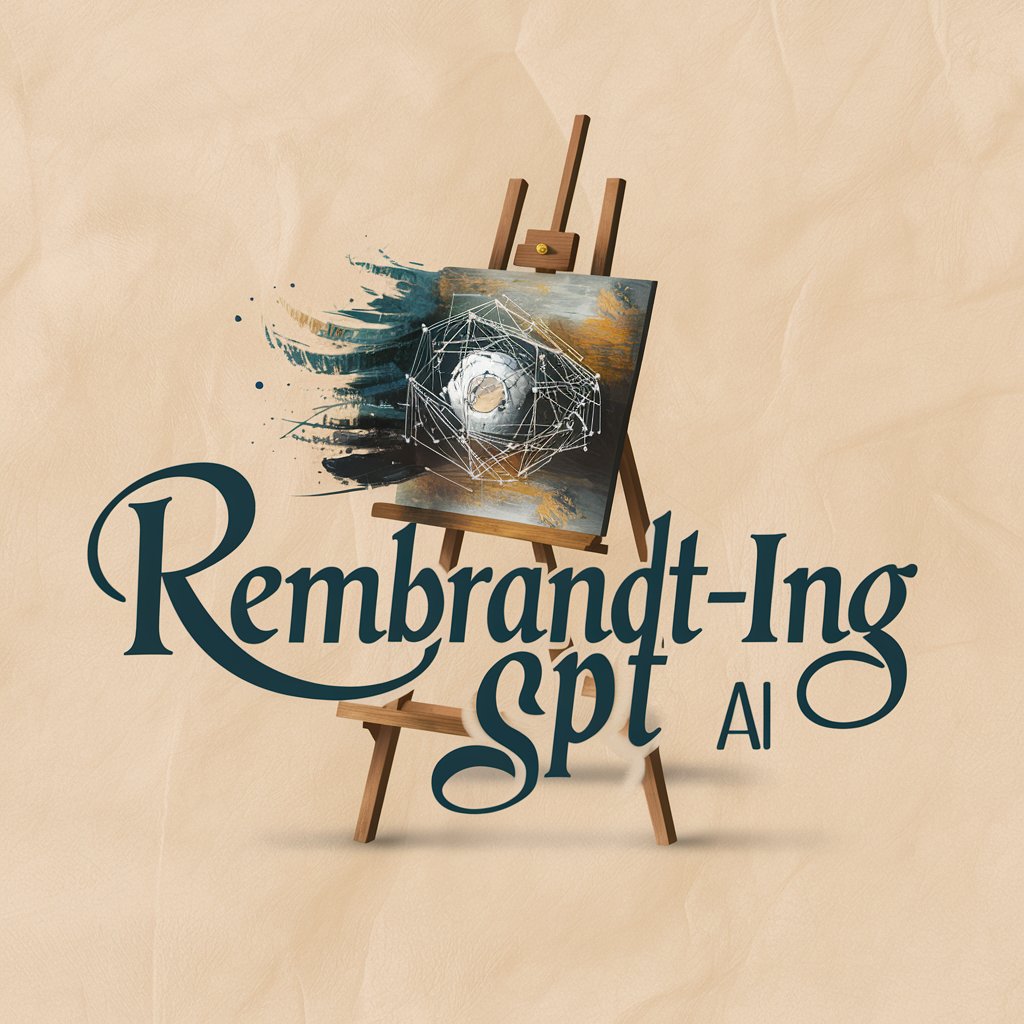
Rembrandt-ing GPT - AI tool generates Rembrandt-style images.

Welcome to Rembrandt-ing GPT, your creative AI.
Transform images into Rembrandt masterpieces.
Create a detailed digital painting of...
Generate a high-resolution image depicting...
Imagine and illustrate a scene where...
Design an intricate portrait featuring...
Get Embed Code
Introduction to Rembrandt-ing GPT
Rembrandt-ing GPT is an AI model designed for image generation and transformation, inspired by the style of the renowned Dutch artist Rembrandt van Rijn. Its primary function is to analyze textual descriptions of images and then generate corresponding images in the style of Rembrandt. The model is named after Rembrandt due to its ability to emulate his distinct artistic style, characterized by rich, dramatic lighting, expressive brushwork, and deep emotional resonance. Rembrandt-ing GPT achieves this by leveraging state-of-the-art language and image generation models, allowing it to interpret detailed descriptions and translate them into visually compelling artworks reminiscent of Rembrandt's masterpieces. For example, users can provide textual descriptions of images, and Rembrandt-ing GPT will generate paintings that capture the essence of the descriptions while adhering to Rembrandt's style. Powered by ChatGPT-4o。

Main Functions of Rembrandt-ing GPT
Image Description Interpretation
Example
Interpreting textual descriptions of images and transforming them into Rembrandt-style paintings.
Scenario
A user provides a detailed description of a landscape photograph, including elements such as lighting conditions, objects present, and mood. Rembrandt-ing GPT analyzes the description and generates a painting that embodies the described scene in the style of Rembrandt.
Image Transformation
Example
Transforming existing images into Rembrandt-style paintings.
Scenario
A user uploads a photograph of a portrait taken with a digital camera. Rembrandt-ing GPT applies its algorithms to transform the photograph into a painting that resembles a Rembrandt masterpiece, enriching it with dramatic lighting and expressive brushwork.
Image Enhancement
Example
Enhancing the aesthetic quality of images by adding Rembrandt-style elements.
Scenario
A user submits a digital artwork for enhancement. Rembrandt-ing GPT processes the image and adds Rembrandt-style lighting effects, textures, and atmosphere, elevating the overall visual impact of the artwork.
Ideal Users of Rembrandt-ing GPT
Artists and Designers
Artists and designers seeking to explore new artistic styles or incorporate Rembrandt's aesthetic into their work can benefit from Rembrandt-ing GPT. They can use the tool to generate Rembrandt-style paintings from textual descriptions or transform existing images into artworks with a Rembrandt-inspired look and feel. This enables them to expand their creative repertoire and offer clients unique and compelling visual solutions.
Art Enthusiasts and Collectors
Art enthusiasts and collectors interested in Rembrandt's art or looking for Rembrandt-style artworks can leverage Rembrandt-ing GPT to acquire personalized paintings. They can provide descriptions of desired scenes or subjects, and the tool will generate custom artworks that evoke the spirit of Rembrandt's oeuvre. This allows enthusiasts to acquire unique and culturally resonant pieces for their collections.
Educators and Researchers
Educators and researchers studying art history, aesthetics, or digital creativity can use Rembrandt-ing GPT as a teaching and research tool. They can analyze how the model interprets textual descriptions and generates images in the style of Rembrandt, providing insights into AI-driven artistic expression and the intersection of technology and visual culture. Additionally, they can explore the implications of AI-generated art for artistic practice, criticism, and intellectual inquiry.

Guidelines for Using Rembrandt-ing GPT
Visit yeschat.ai for a free trial without login, also no need for ChatGPT Plus.
Users can access Rembrandt-ing GPT by visiting yeschat.ai, where they can utilize the tool without the need for a login or ChatGPT Plus subscription.
Input Image Description
Describe the image in detail, including format, perspective, mood, dominant colors, textures, text content, and any aberrations. This step is crucial for generating an accurate Rembrandt-style image.
Generate Rembrandt-style Image
Rembrandt-ing GPT automatically generates a painting in the style of Rembrandt based on the provided image description.
Review and Adjust
Review the generated image and make any necessary adjustments to ensure it meets expectations. Users can iterate on the process by refining the image description for better results.
Download or Share
Once satisfied with the generated image, users can download it for personal use or share it with others as desired.
Try other advanced and practical GPTs
CV Assistant with the Harvard Model
Empower Your Job Hunt with AI

Budismo
Enlighten Your Path with AI

SummitGPT
Empowering Creativity with AI

PeaceGPT
Navigating conflicts with AI empathy

Language
Empower Your Words with AI

ADRLX Marketing & Social Platform Troubleshooter
AI-driven solutions for platform-specific marketing challenges.

Sales Scripter
Craft Your Pitch with AI Power

Culinary Companion
Cook smarter with AI-powered recipes

UK Tax Navigator
Navigating UK Tax with AI-Powered Precision

Asian Chef
Explore Asian cuisine with AI guidance.

Cloud Conversator
Your AI-powered emotional companion.

CoupleCoach GPT
Empowering Relationships with AI Insight

Q&A about Rembrandt-ing GPT
What is Rembrandt-ing GPT?
Rembrandt-ing GPT is an AI-powered tool that generates images in the style of the renowned artist Rembrandt. It uses advanced algorithms to transform image descriptions into Rembrandt-style paintings.
How accurate are the generated Rembrandt-style images?
The accuracy of the generated images depends on the quality and specificity of the image descriptions provided. Detailed descriptions lead to more faithful representations of Rembrandt's style.
What types of images can be transformed into Rembrandt-style paintings?
Rembrandt-ing GPT can transform various types of images, including photographs, digital artwork, and illustrations, into Rembrandt-style paintings.
Is Rembrandt-ing GPT suitable for professional use?
Yes, Rembrandt-ing GPT can be used for professional purposes such as creating unique artwork, enhancing visual content for presentations, or adding artistic flair to marketing materials.
How can I improve the quality of the generated images?
To improve image quality, provide detailed and specific image descriptions, including perspective, colors, textures, and any unique characteristics. Iterating on the image description based on initial results can also lead to better outcomes.